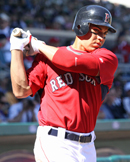
October 7, 2007
You would think the recent baseball game between the New York Yankees and the Cleveland Indians had a chapter in it snatched straight from a cryptozoological book. During the game, insects bothered, to no end, the infielders and pitcher Joba Chamberlain for the Yankees, but less so, it seems the Indians. The bugs remain cryptid.
The reaction to them, however, has been remarkable.
Big bad Yankees pitcher Roger Clemens was so horrified by the insect invasion he told the media Saturday at Yankee Stadium: “I would have probably pulled us off the field.”
The insects were filmed, could have been collected, and yet during the game and right afterward, their identification seems to elude all.
No one was quite sure the type of insect. Some said they were gnats, but there were other theories. “Like small pterodactyls,” [Casey] Blake [of the Indians] said. “Kind of mosquito-like.”
Bart Swain, the director of media relations for the Indians, said such swarms occur a couple times each season at Jacobs Field, usually when the air is still and humid. He said it might have something to do with the city’s proximity to Lake Erie.
But what kind of bugs were they, and why were they there?
Wayne Berisford, a professor of entomology at the University of Georgia in Athens, said last night in a telephone interview that the bugs, gnats or otherwise, were likely engaged in a mating swarm. He said warm and wet weather encourages such behavior. – by Joe LaPointe, “In Game 2 Infestation, Bugs Claim Spotlight,” New York Times, October 6, 2006.
The official site for MLB has this to say:
A reporter for Friday’s broadcast on TBS identified the bugs as Canadian Soldiers, but apparently they were smaller. Since these bugs weren’t looking for food, and probably had come from nearby Lake Erie in search of moisture, the bug spray actually had very little effect on getting rid of the pests. According to the Associated Press, in a game taking place against the Angels at Jacobs Field in September 2004, play was stopped several times after players complained of swallowing the bugs while running the bases.– by Scott Merkin / MLB.com, October 6, 2006.
Sports reporter Jason Logan declared: “Those flying ants cost the Yankees the game.”
The identification of the insects would not seem that difficult, but you can read of them being called midges, ghats, and flying ants.
What were they?
=========
As a sidebar, especially considering the Yankees were playing the Indians, I note the less-than-random coincidence that relief pitcher Joba Chamberlain is a member of the Winnebago of Nebraska.
There are only two other Native Americans currently playing in Major League Baseball today, and all three of them have been involved in playoff action this year.

Rising star: Jacoby Ellsbury.
One is Jacoby Ellsbury, who is the pride of the Navajo Nation, as well as the pride of Boston Red Sox Nation. Ellsbury is the first person of Dine’ (Navajo) descent to be a major league baseball player. I watched him play in Portland, Maine, with the Sea Dogs, and he is a speedy, talented player, who is deeply aware of his role model position in his Native community. Ellsbury is truly a player of the future to watch, overall.
Kyle Lohse (name pronounced “lōsh”), from Chico, California, is a right-handed starting pitcher for the Philadelphia Phillies. Lohse is Nomlaki, who are a Wintun people native to the area of the Sacramento Valley extending westward to the Coast Range in Northern California. The early 20th century anthropologist Alfred L. Kroeber, best known for his work (1911-1916) with the last California Yahi Indian Ishi, said the estimated population of the Nomlaki, Wintu, and Patwin in 1910 was only 1,000.
The Cleveland Indians, where this story all began, traditionally have fostered the legend that they were named in honor of Louis Sockalexis when they assumed their current name in 1915. Sockalexis, nicknamed “The Deerfoot of the Diamond,” a Penobscot from Old Town, Maine, had played for the then-Cleveland Spiders from 1897-1899.

The Cleveland Indians logo, Chief Wahoo (right) is allegedly based on the late Louis Sockalexis (left), the Maine Penobscot after whom the team says it was named. But doesn’t the Wahoo image seem a bit off in today’s marketplace?
From a point of view due to my Eastern Band Cherokee descent, cryptozoologically-mindedness, and Red Sox affinities, I must observe that baseball, bugs, Native peoples, and hominology/cryptozoology can all come together on a warm October night in North America.
About Loren Coleman
Loren Coleman is one of the world’s leading cryptozoologists, some say “the” leading living cryptozoologist. Certainly, he is acknowledged as the current living American researcher and writer who has most popularized cryptozoology in the late 20th and early 21st centuries.
Starting his fieldwork and investigations in 1960, after traveling and trekking extensively in pursuit of cryptozoological mysteries, Coleman began writing to share his experiences in 1969. An honorary member of Ivan T. Sanderson’s Society for the Investigation of the Unexplained in the 1970s, Coleman has been bestowed with similar honorary memberships of the North Idaho College Cryptozoology Club in 1983, and in subsequent years, that of the British Columbia Scientific Cryptozoology Club, CryptoSafari International, and other international organizations. He was also a Life Member and Benefactor of the International Society of Cryptozoology (now-defunct).
Loren Coleman’s daily blog, as a member of the Cryptomundo Team, served as an ongoing avenue of communication for the ever-growing body of cryptozoo news from 2005 through 2013. He returned as an infrequent contributor beginning Halloween week of 2015.
Coleman is the founder in 2003, and current director of the International Cryptozoology Museum in Portland, Maine.
Filed under Breaking News, Cryptomundo Exclusive, Cryptotourism, CryptoZoo News, Cryptozoologists, Cryptozoology, Forensic Science, Media Appearances, Pop Culture, Swamp Monsters, Television